
Web Version of the Poster presented at EUG99, Strasbourg
The present study is an extension of an EC project conducted in 1991-94 on ore beneficiation processes
Our Department has been involved, in 1992-1995, in a BRITE-EURAM
project devoted to the optimization of
beneficiation processes of
Niobium ores of the Lueshe mine (North Kivu, at that time Zaire). The
precise characterisation of the
ores and associated rocks was
carried out through the close cooperation between three teams
involved the following tasks:
systematics of pyrochlore chemistry by British Museum team (UK),
determination of modal compositions by quantitative X-ray diffraction at Louvain-la-Neuve University (Belgium),
bulk chemistry of ores and laterites by our team (Ecole des Mines de Saint Etienne).
The main Tasks of the project were:
distribution of pyrochlore and phosphate minerals
size distribution of the pyrochlore in the Lueshe ore
chemical variation in the pyrochlore
References:
Albers K.H., Bilal E., Garcia D., Gruffat J.J., Guy B., Meixner K., Moutte J., Nasraoui M., Philippo S., Schürmann B., Sonnet P., Verkaeren J., Wall F., Williams T., Woolley A. (1993). "Applied mineralogy pyrochlore and related minerals inof the weathering zones of the niobium deposits of the Lueshe and Bingo carbonatites, Zaïre". Final Report, Contract CCE MA2M-CT90-0038
Nasraoui M. (1996) "Le gisement de niobium de Lueshe (nord est du zaire): évolution géochimique et minéralogique d'un complexe carbonatitique en contextes hydrothermal et supergène", Thèse Ecoles des Mines de Paris et Saint Etienne.
Besides the analytical tasks carried out on samples provided by
GfE for the EC project itself, we undertook a geological study
aimed
at understanding more directly the processes.
The methodology designed for the EC project has been applied to an extended set of samples.
The larger number of fresh rocks analyzed allows for a better charcaterization of the possible protoliths of the Niobium- bearing protoliths.
Different sampling strategy of the laterites
detail of the 'transition' from apatite- to crandallite-laterite
High sample density
fine scale structure of the deposit
Using bulk chemistry of laterite for an intrepretation in terms of phase assemblage evolution
Petrography
H.v.Maravic (doctoral dissertation, Berlin, 1983):
__cancrinite syenite intruded by calcite-carbonatite
(aegyrine-bearing and with feldspathic 'nodules' derived from
syenitic inclusions) > primary Nb-enrichment
__dolomite-carbonatite (no associated silicates)
Geochemistry
Strong complementarity (chemistry, mineralogy) between cancrinite syenite and soevite (similarity with compositions of conjugate liquids produced by immiscibility of a carbonated silicate melt)
Geomorphology :
reflects two main stages of evolution,
1. formation of a
peneplain (cf. Bitobitoba plateau, at 1700 m asl, to the North), with
iron crust formations and limnic/ lacustrine deposits
2. strong
dissection in relation with regional uplift > extensive supergene
alteration in high drainage conditions
Carbonated framework readily dissolved >> no preserved
textures in the laterites, abundance of collapse structures, listric
faults, etc.
presence of allochtonous alterites (e.g.
fluvio-lacustrine formations) in the upper part of the profile
strong heterogeneity of possible parent rocks (esp. carbonatites
with pyroxenitic and feldspathic nodules)
High geochemical variability
>> Statistical approach on interelement ratios using an extended set of geochemical data on fresh rocks (100+ samples) and laterites (250+ samples)
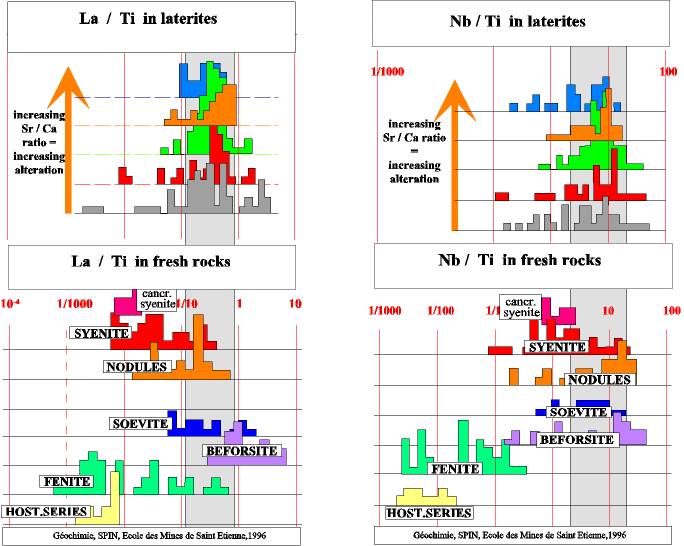
Consistent signatures given by interelement ratios betweenTi, Nb, Zr, La, ...
the laterite population has a consistent and well constrained geochemical signature
this part of the orebody results from in situ alteration of soevites and associated silicate nodules, without significant mixing of allochtonous laterites
4. From Bulk Chemistry to Mineralogy: Phosphate Norm
a. Scheme of the Normative Calculation
<0> Weight percent composition >> Number of Atom
<1> Fe,Mn,Ti oxydes
<2> Phosphates
Ca:=Ca+Sr
IF (Ca > 5/3 P) THEN (Calcite + Apatite)
ELSE
IF (Ca > 1/2 P) THEN (Apatite + Crandallite)
ELSE (Crandallite + Wavellite);
Al:= Al - (Al in Phosphate)
<3>
Silicates
Na,K in Felspars, recalculate Si,Al,
Si,Al is recast into
'kaolinite' + quartz or 'kaolinite' + 'montmori'
b. Validation of the Normative Scheme :
Comparison of Normative results with Modal compositions (quantitaive XRD, U.C.Louvain).
Modal Crandallite correlated with sum of Normative Al-phosphates
Correlation between Modal and Normative Quartz (quartz-bearing laterites in the upper part of the mine)
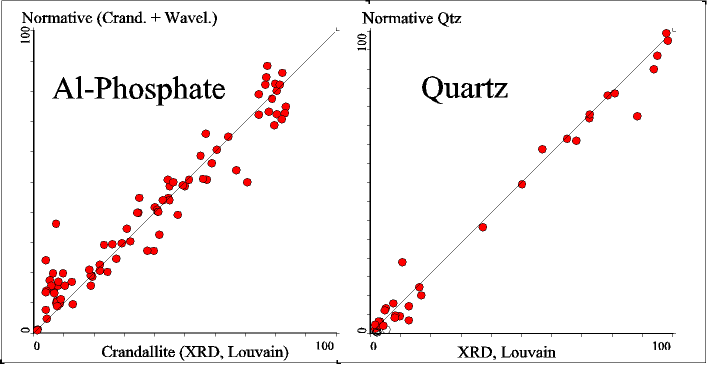
Main feature of the alteration profile (Maravic, Albers et al, op.cit.):
lower part, apatite-bearing
upper part, crandallite-bearing
a. Ca-P-Al
leaching of Calcium is the most striking feature of the alteration
profile,
it proceeds step by step:
the laterite compositions
are distributed along tie lines controlled by the main minerals of
each alteration zone
>> two main fronts of decalcification
:
1. dissolution of calcite > apatite as the only Ca-bearing
phase,
2. destabilization of apatite > crandallite

Ca+Sr / P histograms

emphasizes mutual exclusion of apatite - crandallite
Ca/
(Ca+Sr)
clear contrast between
=apatite constant Sr/Ca,
probably close to its value in fresh rocks,
=Al-phosphates very
large range of variation, up to 50 % of normative goyazite,
>>
evolution within crandallite zone is monitored by Sr-Ca
cation-exchange
b. Si- Al- Na+K, Si- Al- P
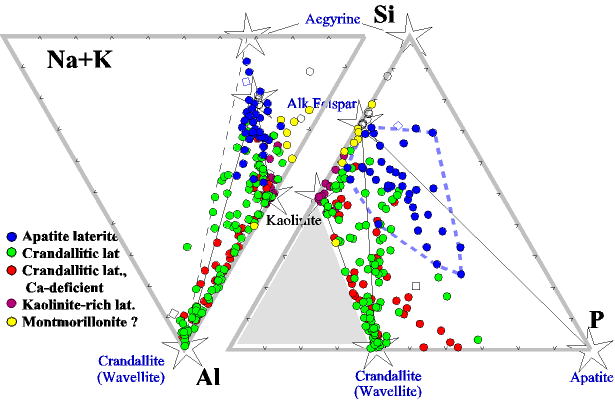
evolution of silicate minerals, coupled with phosphate evolution
kaolinite is the dominant supergene silicate (clay mineral with
higher Si>Al locally present, transitional to kaolinite, in low
drainage part)
strong link between apatite (-) and kaolinite (+)
> apatite destabilisation is related to availability of aluminum released breakdown of primary Al-bearing silicates
<Cross section>
at 1500 m asl, 140 metres long, from fresh carbonatite to highly evolved crandallite laterites.
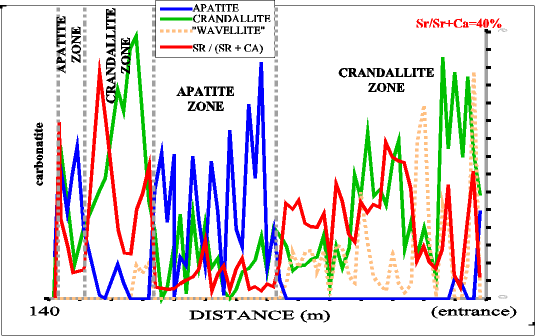
large oscillations: reflects mainly the protolith heterogenity
crandallite close to fresh carbonatite, apatite zone further East: indicative of the hydrological structure (strong permeability contrast near fresh rock and steep structure > high drainage) a zone of lower drainage (montmorillonite)
<Map>
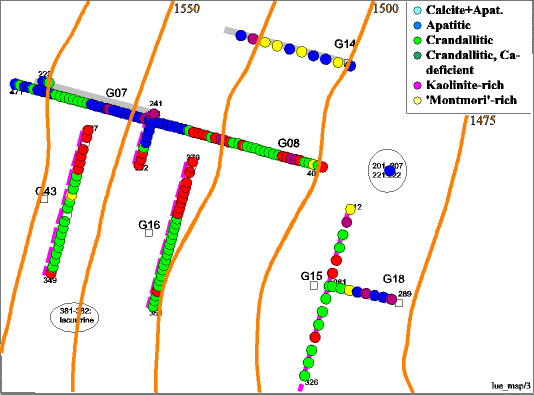
Projection of normative assemblaes
High sample density (2 m) > definition of fronts between the main zones
Zone of lower drainage (montmorillonite) in the Northern part
Although generally used as a descriptive tool, useful only for gross quantification and mass balance calculations, the whole rock chemical approach can be, once the mineral assemblages have been characterized on a limited number of representative samples, a powerful tool for the interpretation of lateritic processes in terms of the evolution of mineral assemblages
High productivity of common methods for bulk chemistry (XRF, ICP-OES)
<> makes possible the systematic analysis of a high density
sample set
<> interpretation in terms of phase assemblages
<> fine scale structure of a supergene deposit
A peculiarity of the Lueshe profile is the absence of secondary apatite (i.e. no absolute enrichment in P).
It may result from the high drainage condition induced by the steep topography of the site of alteration Lueshe profile develops mostly above the water table, whereas secondary apatite would require high levels of carbonate / calcium activities associated with saturated conditions